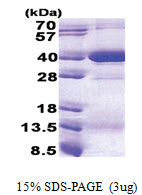HLA class I Cw7 alpha / HLA-C (25-308, His-tag) Human Protein
CAT#: AR51046PU-S
HLA class I Cw7 alpha / HLA-C (25-308, His-tag) human protein, 0.1 mg
Size: 500 ug
Other products for "HLA-C"
Specifications
| Product Data | |
| Species | Human |
| Expression Host | E. coli |
| Expression cDNA Clone or AA Sequence |
MGSSHHHHHH SSGLVPRGSH MGSCSHSMRY FDTAVSRPGR GEPRFISVGY VDDTQFVRFD SDAASPRGEP RAPWVEQEGP EYWDRETQKY KRQAQADRVS LRNLRGYYNQ SEDGSHTLQR MSGCDLGPDG RLLRGYDQSA YDGKDYIALN EDLRSWTAAD TAAQITQRKL EAARAAEQLR AYLEGTCVEW LRRYLENGKE TLQRAEPPKT HVTHHPLSDH EATLRCWALG FYPAEITLTW QRDGEDQTQD TELVETRPAG DGTFQKWAAV VVPSGQEQRY TCHMQHEGLQ EPLTLSWEPS SQPTIPI
|
| Tag | His-tag |
| Predicted MW | 34.9 kDa |
| Concentration | lot specific |
| Purity | >90% by SDS - PAGE |
| Presentation | Purified |
| Buffer | Presentation State: Purified State: Liquid purified protein Buffer System: 20 mM Tris-HCl buffer (pH 8.0) containing 0.15M NaCl, 20% glycerol, 1 mM DTT |
| Preparation | Liquid purified protein |
| Storage | Store undiluted at 2-8°C for one week or (in aliquots) at -20°C to -80°C for longer. Avoid repeated freezing and thawing. |
| Stability | Shelf life: one year from despatch. |
| Reference Data | |
| RefSeq | NP_001229971 |
| Locus ID | 3107 |
| UniProt ID | O19617 |
| Cytogenetics | 6p21.33 |
| Synonyms | D6S204; HLA-JY3; HLAC; HLC-C; MHC; PSORS1 |
| Summary | HLA-C belongs to the HLA class I heavy chain paralogues. This class I molecule is a heterodimer consisting of a heavy chain and a light chain (beta-2 microglobulin). The heavy chain is anchored in the membrane. Class I molecules play a central role in the immune system by presenting peptides derived from endoplasmic reticulum lumen. They are expressed in nearly all cells. The heavy chain is approximately 45 kDa and its gene contains 8 exons. Exon one encodes the leader peptide, exons 2 and 3 encode the alpha1 and alpha2 domain, which both bind the peptide, exon 4 encodes the alpha3 domain, exon 5 encodes the transmembrane region, and exons 6 and 7 encode the cytoplasmic tail. Polymorphisms within exon 2 and exon 3 are responsible for the peptide binding specificity of each class one molecule. Typing for these polymorphisms is routinely done for bone marrow and kidney transplantation. About 6000 HLA-C alleles have been described. The HLA system plays an important role in the occurrence and outcome of infectious diseases, including those caused by the malaria parasite, the human immunodeficiency virus (HIV), and the severe acute respiratory syndrome coronavirus (SARS-CoV). The structural spike and the nucleocapsid proteins of the novel coronavirus SARS-CoV-2, which causes coronavirus disease 2019 (COVID-19), are reported to contain multiple Class I epitopes with predicted HLA restrictions. Individual HLA genetic variation may help explain different immune responses to a virus across a population.[provided by RefSeq, Aug 2020] |
| Protein Families | Secreted Protein, Transmembrane |
| Protein Pathways | Allograft rejection, Antigen processing and presentation, Autoimmune thyroid disease, Cell adhesion molecules (CAMs), Endocytosis, Graft-versus-host disease, Natural killer cell mediated cytotoxicity, Type I diabetes mellitus, Viral myocarditis |
Documents
| FAQs |
| SDS |
Resources
Recombinant Protein Resources |
{0} Product Review(s)
0 Product Review(s)
Submit review
Be the first one to submit a review
Product Citations
*Delivery time may vary from web posted schedule. Occasional delays may occur due to unforeseen
complexities in the preparation of your product. International customers may expect an additional 1-2 weeks
in shipping.






























































































































































































































































 Germany
Germany
 Japan
Japan
 United Kingdom
United Kingdom
 China
China
